#Rocketdyne F-1
Explore tagged Tumblr posts
Text

"This image depicts a Boeing worker installing an F-1 engine on the Saturn V S-IC flight stage at the Michoud Assembly Facility (MAF). The Saturn IB and Saturn V first stages were manufactured at the MAF, located 24 kilometers (approximately 15 miles) east of downtown New Orleans, Louisiana. The prime contractors, Chrysler and Boeing, jointly occupied the MAF. The basic manufacturing building boasted 43 acres under one roof. By 1964, NASA added a separate engineering and office building, vertical assembly building, and test stage building."
Date: November 1967
NASA ID: 6760478
#Rocketdyne F-1#F-1#Rocket Engine#S-IC#Saturn V#Rocket#NASA#Apollo Program#Construction#Michoud Assembly Facility#New Orleans#Louisiana#November#1967#my post
55 notes
·
View notes
Text
I can't find a source from a real quick look but the hoops and striations are because the engine bell is made from a zillion little pipes brazed together, so it can be liquid-cooled with the liquid oxygen that's then burned.




Photographs of the Saturn V rocket by Dave Wilson, 2014
4K notes
·
View notes
Text

F-1 engine installation into first stage of Saturn V.
0 notes
Text
ArtStation - Rocketdyne F-1 (Saturn V Engine) │ 3D Hero Prop, Martin Martschenko
0 notes
Text
Ulysses
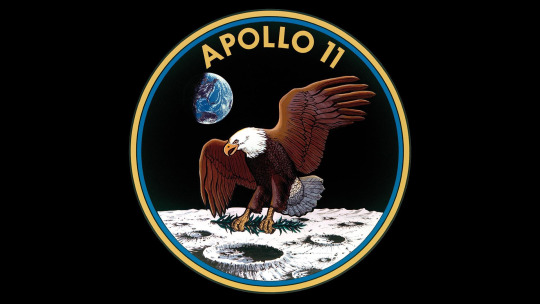
Exploration is in our nature. We began as wanderers, and we are wanderers still. We have lingered long enough on the shores of the cosmic ocean. We are ready at last to set sail for the stars. Carl Sagan, Cosmos, 1980
In the prologue to the Apollo moonshot the mastery of spacewalks, rendezvous, docking, long-duration flights, reentry and precision landing had to be mastered first by the workhorse of the Gemini Project. The practical application of theoretical physics cultivated by a series of tutorials was the risk mitigation needed to thread the needle of docking in orbit and to walk atop the lunar surface for the Apollo excursion. Over twenty months as each new mission’s complexity became more edifying than the last NASA laid the groundwork for this big exploit. Rendezvous entailed station-keeping and docking between two craft in a zero-G environment. The moonwalk although etched in civilization’s hagiography with the iconic images of Neil Armstrong and Buzz Aldrin cavorting about on the Moon would only materialize after Gemini’s 12 hours and 25 minutes of spacewalks (Machell 1967). Multiple redundancies of backups were also exported into Apollo to eschew primary-system failures. In the gospel of engineering such failsafe devices are critical to isolate malfunctions that can cascade into catastrophe. Amidst the Gemini VIII mission a runaway thruster convulsed the vehicle into an uncontrollable spin until the last-minute Hail Mary pass by astronaut Armstrong arrested the rate of rotation. Learned mistakes then bolstered Apollo.
As the apotheosis of the space programme Washington’s industrial policy did not exercise any austerity for the successor to the Mercury and Gemini projects. In its Keynesian stimulus for a dash of Cold War bravado NASA mobilized over 20,000 industrial firms at the cost of $25.4b or $186b in real value (DiLisi et al. 2019). This fiscal demand mimicked the audacity of landing a man on the Moon versus splitting the atom in the Manhattan Project which was monetized at $2b or 34 billion in constant dollars. Nuclear fission at the Los Alamos Laboratory at its zenith saw a headcount of 130,000 personnel in a foil to the moonshot’s 400,000 (Huges 2003). Therefore in Apollo’s anatomy a bevy of august firms were conscripted into service for the three million working parts of the Saturn V rocket whose power could be analogized to the output of eighty-five Hoover Dams (Bilstein 1999). It was this crown jewel of the space programme dwarfing Mercury’s Redstone and Gemini’s Titan II that brought humanity to the Moon and back. Washington’s calculated use of public funds architected an entire industry from the ground up in the space race. Between the creation of the bureaucratic mechanism in the guise of NASA and pecuniary investments in R&D an Industrial Revolution was co-authored by state-driven capitalism and firms.
Apollo embodied the Everest of engineering across the gamut of rocketry, metallurgy, thermodynamics, aerodynamics and astrophysics to cement man’s presence onto the distant orb of the Moon. But success is not at all the default of industrial policy when bureaucracies are prone to beget sinkholes of profligate spending. Where Washington excelled was to marshal a uniformity of purpose for the high stakes of President Kennedy’s promise to plant America’s flag atop the Moon. A delegation of contracts solicited expertise from Boeing, Chrysler, Rocketdyne, North American Aviation’s Space and Information Systems Division (S&ID), Douglas Aircraft, IBM and Grumman. NASA’s Marshal Space Flight Centre in Alabama helmed by the feted von Braun and his retinue coordinated all these discrete nodes of operations. Boeing and Chrysler were tasked with integrating the five F-1 engines abreast of fuel tanks and avionics for the first stage of the Saturn V rocket. Rocketdyne designed those mainstay engines together with its J-2 variant. These smaller units were married to the upper stages whose in-flight restarts parked Apollo into earth’s orbit whereupon a second controlled burn pushed the craft into its Trans-Lunar Injection path. Reawakening an engine in the cold vacuum of space was fraught with complexity.
Within this leg of propelling astronauts beyond earth’s upper atmosphere it was S&ID that fitted the five J-2 powerplants to its second stage vehicle. These furnaces of thrust catapulted Apollo into orbit to await its manoeuvre towards the alien plains of the Moon. Inside the cylindrical hull fabricated from alloyed aluminum were vast reservoirs that cradled the propellants of liquid hydrogen and oxygen. Next to this coup of engineering would be the third stage manufactured by Douglas Aircraft whose import hinged on slingshotting the crew on its final approach to its mission objective. This smaller sibling of the Saturn V rocket innovated the bulkheads separating fuels with a substantial cut in mass for greater efficacy of operations when weight was at a premium. Right above this third stage sat IBM’s magnum opus. Wrapped around the circumference of the Saturn V there stood a three-foot high ring of digital computers and sensors in miniaturized form computing trajectories across the sky and into the sea of stars. Micro-adjustments in milliseconds remedied thrust deficits and directions across the battery of engines should one fail. Directly abutting the foregoing nerve centre of the Saturn V there nestled in the upper stages of the rocket was the Lunar Module under the stewardship of the Grumman Aircraft company.

This vehicle draped in Kapton foil since the want of an atmosphere fails to mediate extreme temperatures would descend upon the Moon’s regolith with a form factor resembling an arachnid. Outfitting the spacecraft with four spindly legs and an engine with modulated thrust ensured a soft landing on the alien world where the streamlined shapes of aerodynamics had no currency. Once ensconced on the surface courtesy of the vehicle’s throttleable velocity the second stage launched the explorers and their soil samples back out into space to rendezvous with the Command and Service Modules. Whilst each facet of the mission proved precocious the mission was greater than the sum of its parts. The alchemy of coordinating a phalanx of companies towards one end of landing a man on the Moon cannot be extolled enough. In this seminal act of innovation not only did a whole industry manifest from nothing but also America’s production shifted wholesale towards a knowledge economy. President Kennedy’s foresight to align industry and academia in colonizing the Moon became the verve and vim behind the boom in innovation that ushered in the era of postindustrialism. The return on investment would be a boon to technology in the crucible of Apollo as the brainchild of Washington’s industrial policy.
0 notes
Text
Saturn V launch vehicle's S-I stage and its 5 Rocketdyne F-1 engines

257 notes
·
View notes
Text

France highlights a Rafale fighter to carry out NATO mission with German Eurofighters
The short-term deployment involved French aircraft to move to the Ämari Air Base, Estonia, from the Siauliai Air Base, Lithuania.
Fernando Valduga By Fernando Valduga 01/31/2013 - 1:00 Pm In Military
A French Rafale parked in the courtyard of Ämari Air Base in Estonia, connected to an auxiliary power unit of the German Air Force. (Photo: Marvin Hofmann / AIRCOM - Allied Air Command)
The French Air and Space Force temporarily deployed a Rafale fighter to support German Eurofighter pilots in carrying out the NATO mission in Estonia.
The deployment was revealed by the NATO Allied Air Command (AIRCOM), which said that the French aircraft was deployed at the Ämari Air Base, Estonia, from the Siauliai Air Base, Lithuania.
After its arrival in Estonia, the French detachment received broad support from its German counterparts.

This also allowed the two forces to carry out 'combat training of various aircraft and operations deployed in a contested environment'.
The short-term implementation also allowed the Rafale jet to perform dispersed operation exercises and cross-service aircraft scenarios with the Eurofighter Typhoon detachment of the German Air Force.

The French commander of the Rafale Detachment, Lieutenant Colonel Jonathan, said: "We carried out this temporary deployment to ensure that our operations continued outside an alternative air base."
German and French fighters are deployed to support NATO's Baltic air policing mission. As part of the training, the French jet Rafale was forced to move to Estonia to fight a simulated threat at Siauliai Air Base.

The scenario also required a limited ground support team from France to arrive at the Siauliai base to receive the deployed Rafale and work with German and Estonian colleagues to prepare the French aircraft for another mission, followed by its final return to Lithuania.

Lieutenant Colonel Bruno Carreiro, a member of the Logistics Operations Division of Aircom, said: “With this short-term deployment of the French Rafale to lodge with the German Eurofighter detachment on a NATO mission, we demonstrated an important cross-service capacity of aircraft and created synergies. The refueling, maintenance and other ground support from Germany for the French Rafale summarize the spirit of the alliance of working together to protect our allies."
Tags: Armée de l'air - French Air ForceMilitary AviationDassault RafaleLuftwaffe - German Air ForceNATO Baltic Air Policing Mission
Fernando Valduga
Fernando Valduga
Aviation photographer and pilot since 1992, he participated in several events and air operations, such as Cruzex, AirVenture, Dayton Airshow and FIDAE. He has works published in specialized aviation magazines in Brazil and abroad. He uses Canon equipment during his photographic work in the world of aviation.
Related news
MILITARY
Aero Vodochody receives authorization to conduct training on L-39NG
31/01/2023 - 16:00
Mirage 2000 (F-2000C) fighters of the Brazilian Air Force. (Photo: Sgt. Johnson Barros)
MILITARY
Mirage 2000 ex-FAB fighters for Ukraine?
31/01/2023 - 12:00
MILITARY
New air-to-air missiles will allow Bayraktar TB2 drones to defeat Iranian UAVs in Ukraine
31/01/2023 - 08:30
MILITARY
Biden says no to the supply of F-16 fighters to Ukraine
30/01/2023 - 23:14
Artistic representation of the hypersonic air breathing weapon concept (HAWC), the result of a partnership between the Defense Advanced Research Projects Agency, the Air Force Research Laboratory, Lockheed Martin and Aerojet Rocketdyne.
MILITARY
DARPA and U.S. Air Force end HAWC hypersonic weapon test flight
30/01/2023 - 20:10
MILITARY
Guyana Defense Force will buy two HAL Dornier 228 utility aircraft from India
30/01/2023 - 16:00
homeMain PageEditorialsINFORMATIONeventsCooperateSpecialitiesadvertiseabout
Cavok Brazil - Digital Tchê Web Creation
Commercial
Executive
Helicopters
HISTORY
Military
Brazilian Air Force
Space
Specialities
Cavok Brazil - Digital Tchê Web Creation
0 notes
Photo

Aerojet Rocketdyne, 8900 De Soto Ave, Canoga Park, CA 91304 (April 13, 2019)
#Rocketdyne#Aerojet Rocketdyne#Canoga Park#Desoto Avenue#rocket engine#f-1 engine#lunar landing#apollo 11#apollo missions
1 note
·
View note
Text

Lockheed F-104G aircraft lined up at Ingolstadt Manching Airport Germany. | Photo: Unbekannter Autor
FLIGHTLINE: 116 - LOCKHEED F-104 STARFIGHTER
The F-104 was designed as a simple, lightweight interceptor with maximum altitude and climb performance.
Springing from the mind of Kelly Johnson and his team at Lockheed, the F-104 was developed in the early 1950s as a blindingly fast, high flying interceptor to engage Soviet bombers. Based on interviews with pilots returning from the Korean war, Johnson wanted to reverse the trend in the USAF toward increasingly heavy and complex fighters. The USAF seemed to agree, issuing a operational requirement on 5 November 1952 for a lightweight day fighter to supplement, if not ultimately replace, the F-100 Super Sabre. In addition to the Lockheed design, which had been given the internal designation L-246, Republic Aviation proposed their AP-55, derived from the XF-91 Thunderceptor, North American advanced the NA-212, which was developed from the F-100, and Northrop submitted their N-102 Fang.
Lockheed was awarded a development contract on 12 March 1953 for two prototypes of the newly-christened XF-104. The initial design had changed in the interim, with data gleaned from the and X-7 programs being incorporated into the new interceptor. The XF-104 now featured a long tubular fuselage, dominated by a single massive J79 turbojet and featuring small wings so thin that they needed covers during maintenance, lest ground crew cut themselves. The V-tail and variable-position horizontal stabilizers had given way to a single T-tail with an all-moving stabilizer.

Schematics of the F-104. | Illustration: Bagera3005 @ DeviantArt
The first flight of XF-104 #1 took place in March 1954, powered by a Wright J65 engine as the J79 was facing issues in development. The XF-104 had small, trapezoidal wings like the X-3 and X-7, and as such the fuel and landing gear would need to be contained in the fuselage. Because the wings and tail were nearly the same size, the wings were given a 10° anhedral to counteract a tendency to Dutch Roll. The high T-tail led to Lockheed installing a unique downward-firing ejection seat, so as to not injure the pilot if he struck the tail. This feature was removed in the production F-104 as ejection seat technology improved. Both XF-104s were lost during the test program, though enough data was acquired that the production F-104A featured numerous improvements and modifications.
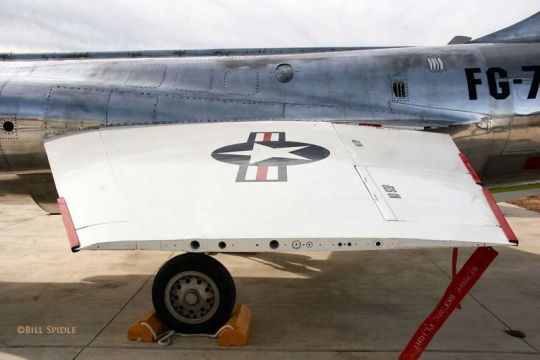
F-104A showing leading and trailing edge covers. | Photo: Bill Spidle
The Starfighter saw service in the USAF from 1958 until 1969, though use continued with the Puerto Rican Air National Guard until 1975. The plane was widely exported, serving in the air forces of 14 other nations, as well as NASA. Canada, Italy and Japan license-built their own copies, with the CF-104 being modified to perform nuclear strike and recon roles, the F-104S designed to fire AIM-7 Sparrow missile, and the F-104J, which resembled the F-104G, but retained the original F-104A’s interceptor-only role.
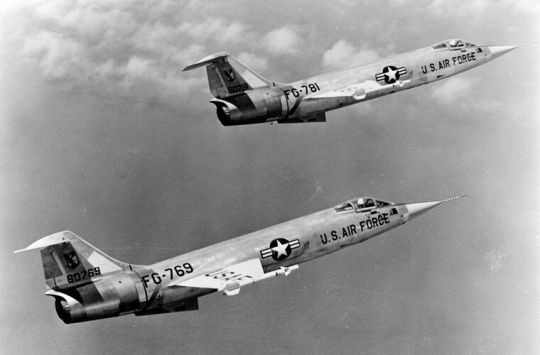
A pair of USAF F-104s, circa 1960, with Buzz Numbers visible on the aft fuselage. | Photo: USAF

An F-104 shooting down a QF-80 drone during a test. | Gif from a USAF film
The F-104C was a fighter bomber variant developed for the USAF's Tactical Air Command (TAC). The radar was improved, and two pylons were added to each wing, along with one under the fuselage, allowing the plane to carry rockets and conventional bombs, along with a single Mk.28 or Mk.43 nuclear weapon. The C model was also equipped with aerial refueling equipment. TAC's F-104C served in Vietnam from 1965 through 1967 before being supplanted by the F-4. Starfighters under the direction of EC-121 Warning Stars shot down 25 MiGs during the war, and 15 F-104s were lost to SAMs, AAA, engine failure, one air-to-air kill by a PLAN J-6, and one mid-air collision.
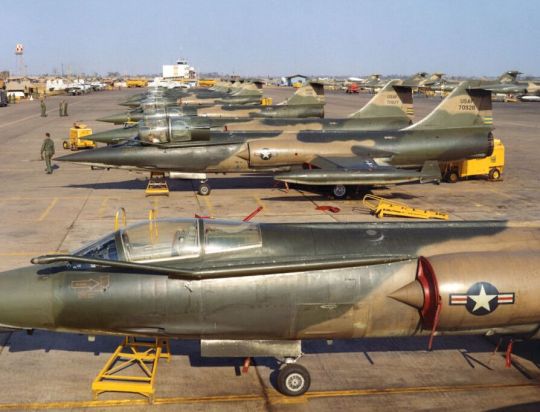
TAC F-104C Starfighters from the 435th Tactical Fighter Squadron, 479th Tactical Fighter Wing, at Udorn Royal Thai Air Force Base in 1965. | Photo: USAF
The F-104G was the definitive variant, and 1,127 were produced by Lockheed, Canadair, and a consortium of Messerschmidt/MBB, Fiat, Fokker and S.A.B.C.A. The type featured a strengthened fuselage, wing, and empennage structures; the larger vertical fin with fully powered rudder as used on the two-seat versions; fully powered brakes, a new anti-skid system, and larger tires; revised flaps for improved combat maneuvering; and a larger braking chute. The G model was also a multi-role aircraft, with 7 hardpoints under the wing and fuselage allowing carriage of AIM-9 Sidewinders, unguided bombs and rockets, and fuel tanks.
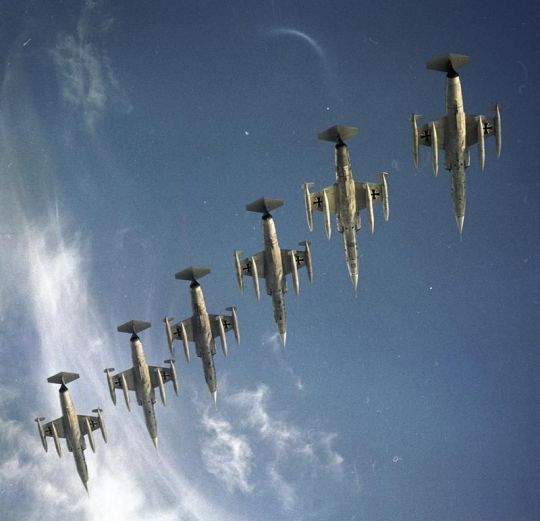
A formation of F-104Gs from the air arm of the German Navy in 1965. | Photo: Marineflieger
It was this multi-role aspect that interested the international community, and the so-called “Deal of the Century” was struck (with bribes greasing the wheels along the way), allowing Lockheed’s new mount to replace a large number of aging first-generation jets. West Germany acquired 915 Starfighters, with 151 going to the Marineflieger and the rest to the Luftwaffe. Though an adequate fighter-bomber, the F-104 design was optimized for high-speed, high-altitude flight, and the adaptations to low-altitude flight were not entirely effective. The plane quickly gained a reputation as being accident-prone, with 270 aircraft lost in West German service and 110 pilots killed. The press dubbed the plane Witwenmacher (‘widowmaker’), and the running joke being “How do you get an F-104 for cheep? Buy a plot of land in West Germany and wait.”. Still, the plane soldiered on in Luftwaffe service, surviving past reunification and being finally retired in 1991.
NASA acquired F-104As in 1963, which were then modified with the addition of a Rocketdyne AR2-3 rocket engine in an angled housing beneath the tail fin, as well as hydrogen peroxide reaction control thrusters, and were used to train pilots for the X-15 and X-20 DynaSoar. One of these NF-104As was lost during a test flight by Chuck Yeager, which was depicted in the book The Right Stuff, as well as the film that was adapted from it.

A NASA NF-104A executing a rocket-assisted zoom climb. | Photo: USAF
Three F-104G aircraft were also acquired by NASA in 1963 for use as high-speed chase aircraft under the designation F-104N. One of these aircraft was famously lost in a mid-air collision with the XB-70A Valkyrie bomber, killing both Joe Walker, pilot of the F-104, and Carl Cross, co-pilot of the XB-70. The other aircraft remained in NASA service until 1994, making it the last Starfighter in US service.
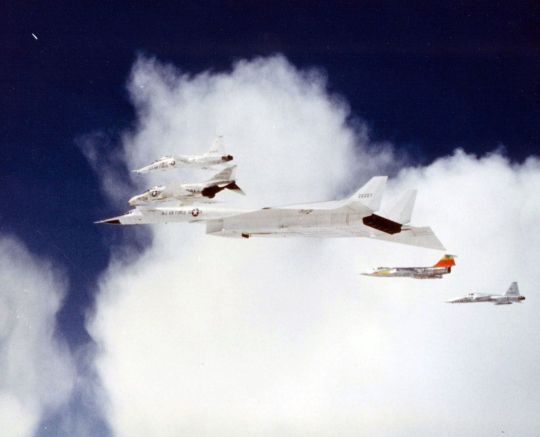
A formation of USAF and NASA aircraft in 1966, From foreground to background they are a T-38A, F-4B, XB-70A, F-104N and YF-5A. The flight had been set up at the behest of General Electric, which manufactured the engines in all 5 craft. | Photo: USAF
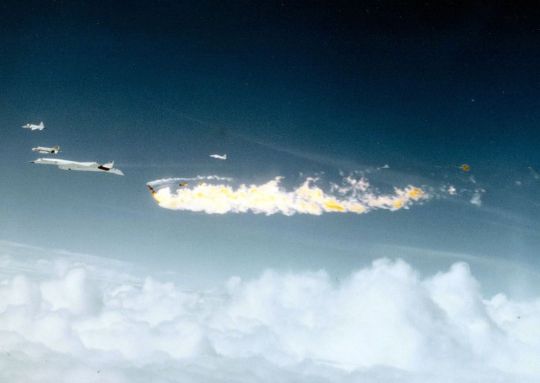
The immediate aftermath of the collision. Investigators determined that Joe Walker in the F-104 lost sight of the XB-70 and drifted into the larger plane's wake vortex, which catapulted the Starfighter across the Valk's back. | Photo: USAF
The F-104, in various models, served with the armed forces of 15 nations, along with NASA and at least one civilian demo team. Italy was the last user, with the F-104S being retired in 2004.
#aircraft#aviation#avgeek#cold war#airplanes#cold war history#airplane#coldwar#usaf#aviation history#Lockheed#lockheed f-104#starfighter#vietnam war#f104#f 104
68 notes
·
View notes
Text
From the tags

The short story is that the apollo rockets weren't made to a design, they were modified, by hand, from the design that the engineers originally made. By the end of it, there were so many undocumented changes that Space X had to reinvent a lot of things for themselves. So, the technology is lost because the people that knew it died without training up others.

59K notes
·
View notes
Text
Os 20 anos de Algo Engraçado Aconteceu a Caminho da Lua, de Bart Sibrel, nos 52 anos do pouso do homem na Lua

A funny thing happened on the way to the Moon (Algo engraçado aconteceu a caminho da Lua, 2001), produzido pelo controverso documentarista e jornalista investigativo Bartholomew Winfield Sibrel, mais conhecido por Bart Sibrel, notório por abordar astronautas em eventos e fazê-los jurar sobre a Bíblia, no que até chegou a levar um soco de Buzz Aldrin, não insiste em questionamentos batidos, como as discrepâncias nas fotos da NASA e o envolvimento do "iluminado" diretor Stanley Kubrick (1928-1999) na armação, mas comprova a farsa com imagens de uma fita da Apollo 11, crua e sem edição, que a NASA lhe enviou “por engano” e que mostra os astronautas no interior da nave encenando parte da missão, como se estivessem a caminho e próximos da Lua, quando estavam em órbita da Terra.
Bart Sibrel e Bill Kaysing (1922-2005) no Japão. Ex-oficial da Marinha dos Estados Unidos, contratado como um escritor técnico em 1956 pela Rocketdyne, a empresa que construiu o motor F-1 utilizado no foguete Saturno V, Kaysing foi o primeiro a questionar a autenticidade das missões Apollo de maneira aberta e contundente. Em 1976, ele lançou o livro We never went to the Moon: America’s tirty billion dollar windle (Nós nunca fomos à Lua: A fraude americana de 30 bilhões de dólares), onde calculava a chance de um pouso tripulado bem-sucedido à Lua em 0,0017%. Foto de Misawo Imajo.

O momento mais revelador é quando malandramente simulam filmar a Terra bem distante, uma pequena bola azul no espaço, usando o simples truque de apagar as luzes do interior da cabine, fechar as janelas para tapar a luz do Sol e filmar apenas uma escotilha, à distância, com a Terra ao fundo focada apenas em parte de sua superfície. Assista abaixo:
youtube
Sibrel exibiu essa fita ao ex-astronauta Edgar Mitchell (1930-2016), o sexto homem a pisar na Lua, como piloto do módulo lunar Antares na missão Apollo 14, em 9 de fevereiro de 1971, que ao ver as cenas expulsou Sibrel de sua residência a pontapés, xingamentos e ameaças. A reação de Aldrin foi parecida. Assista abaixo:
youtube
A NASA não refutou essa história até hoje, e a Rússia, que reconhecia ter perdido a corrida espacial à Lua para os EUA, abriu em 2015 uma investigação oficial sobre a veracidade das missões Apollo. Sibrel sustenta que a tripulação da Apollo 11, bem como os astronautas das missões seguintes, falsificaram suas órbitas em torno da Lua e seus passeios em sua superfície via fotos trucadas, e que eles não foram além de metade do caminho à Lua. Assista ao documentário A funny thing happened on the way to the Moon aqui:
youtube
Em Os astronautas se tornam loucos (Astronauts gone wild, 2004), continuação de Algo engraçado aconteceu a caminho da Lua, Bart Sibrel confronta pessoalmente oito astronautas da NASA, que reagem de maneira violenta e não condizente com o comportamento que seria esperado de homens “eleitos” e equilibrados suficientes para irem ao espaço.

Sibrel foi agredido fisicamente por dois astronautas e ameaçado de ser assassinado por outro… tudo diante das câmeras! Sibrel atestou que esses homens não são os “heróis” honrosos que parecem ser, ao contrário, são meros atores, fingidores raivosos e violentos que não hesitam em partir para a ignorância ao verem seus atos mentirosos e malignos expostos. Assista abaixo:
youtube
Aos 8:58, o astronauta Buzz Aldrin é confrontado com o filme que mostra ele e seus dois companheiros (Armstrong e Collins) no interior da nave encenando parte da missão Apollo 11, como se estivessem a caminho e próximos da Lua, quando estavam em órbita da Terra. Aldrin reconheceu a fraude pensando que estava em off, com a câmera desligada. Quando Aldrin percebeu que havia feito uma admissão de culpa, ameaçou processar Sibrel se a entrevista fosse exibida publicamente…
youtube
Aos 13:40, o astronauta Alan Bean (1932-2018), o quarto homem a pisar na Lua (em novembro de 1969, com a Apollo 12), acidentalmente reconheceu que ele nunca saiu da órbita da Terra e afirmou enfaticamente que não viajou através dos Cinturões de Radiação Van Allen, que estão a mais de 40.000 quilômetros além da órbita da Terra. Quando sua hipocrisia ficou patente, fez uma fraca tentativa de se recuperar de seu erro.
youtube
Aos 40:29, Sibrel ofereceu ao astronauta Neil Armstrong US$ 5.000 em dinheiro para doar à sua instituição de caridade favorita, bastando que jurasse sobre a Bíblia que ele realmente pisou na Lua. Em atitude surpreendente, Armstrong se recusou a ajudar a instituição de caridade com apenas uma declaração formal do que é suposto ser verdade…
youtube
Aos 48:32, o astronauta “holístico” e “pacificista” Edgar Mitchell agrediu violentamente Sibrel por trás com um chute e ameaçou pegar sua arma e atirar nele! Esquecendo-se que o microfone sem fio ainda estava ligado depois que ele fechou a porta e Sibrel saiu, o áudio confidencial revelou Mitchell e seu filho conversando sobre acionar seus amigos na CIA para assassinar Sibrel. Com ironia e deboche, Sibrel disse que “Não é justo que meus impostos sejam usados para pagar meu próprio assassinato!”
youtube
No final de Astronauts gone wild, Sibrel apresenta um pequeno filme cômico que ele criou chamado Getting waxed, inspirado na ameaça do astronauta Mitchell, no qual a CIA o persegue para seus desonestos propósitos. Ainda que os métodos de abordagem de Sibrel sejam por vezes um tanto intrusivos, a reação dos astronautas é desproporcional e, como disse, não condizente com homens da estatura que todos acreditam que sejam.
youtube

#Apollo 11#Bart Sibrel#moon landing#moon hoax#neil armstrong#buzz aldrin#michael collins#nasalies#cover up#conspiracies#Youtube
3 notes
·
View notes
Text
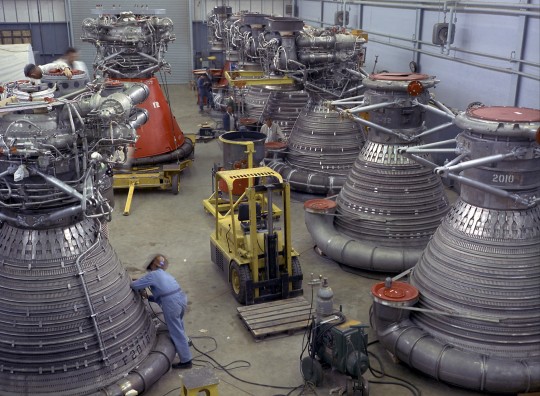
"This photograph shows F-1 engines being stored in the F-1 Engine Preparation Shop, building 4666, at the Marshall Space Flight Center. Each F-1 engine produced a thrust of 1,500,000 pounds. A cluster of five engines was mounted on the thrust structure of the S-IC stage of a 364-foot long Saturn V launch vehicle that ultimately took astronauts to the Moon."
Date: March 1965
NASA ID: 6521185
#Rocketdyne F-1#F-1#Rocket Engine#NASA#Apollo Program#Marshall Space Flight Center#MSFC#Huntsville#Alabama#March#1965#my post
112 notes
·
View notes
Text
The Saturn V super heavy launch vehicle is a multistage NASA rocket, utilizing 5 Rocketdyne F-1 gas combustion cycle engines on it's base stage which are capable of carrying 50.1 tons into trans lunar injection. The rocket was used for all of the Apollo program and Skylab.
2 notes
·
View notes
Photo


New Posters Available!
2019 marks fifty years since the first moon landing, when Eagle - the lunar lander of Apollo 11 touched down. To commemorate that historic moment, and because I just love everything about the Apollo missions, I’ve created a couple of posters.
The first, Twelve Human Hearts, celebrates the humans to have stepped on the surface of the moon. It’s a huge shame that nobody has been back since Apollo 17.
The second poster, F-1, marks the power and brilliance of the Rocketdyne F-1 engine that powered the Saturn V rocket.
Both posters are available from Ellipress. You can also get them as postcards.
You can, if you’d like, support me on Patreon.
You can find more of me, and my work, here… Facebook Instagram Wordpress Twitter Artstation
If you like my work you can, if you like, buy me a coffee (Ko-fi) to keep me going!
51 notes
·
View notes
Photo

Saturn V Rocketdyne F-1 engine on display in Apollo exhibit at the Museum of Flight in Seattle, WA. Five F-1 engines were used for the first stage of the Saturn V.
#science#technology#engineering#lunar#moon#spacecraft#rocket#apollo#apollo11#apollo 11#apollo 50#saturn v#space#terakuhn
48 notes
·
View notes
Video
tumblr
Video Clip SS2921075 (Saturn V Lift Off, Apollo 11)
This is slow motion footage of the historic launch of Apollo 11 on July 16th, 1969, that would put the first human beings on another heavenly body.
The view is looking down onto the first stage of the Saturn V rocket, as it sits on the pad during the last minute before ignition and launch.
A small explosion of cryogenic fuel boils out from a vent as a swing arm detaches and moves back towards the rocket gantry and out of the way.
Ignition of the five F-1 engines happens at one minute into the clip. As the oxygen in the flame trench is suddenly used up, air is sucked in from around it and from above. This is why the fresh puffs of black smoke suddenly retreat downwards.
View More Saturn V Launch Videos
The vibrations from ingition begin to shake ice from the outside of the vehicle and large white slabs and fragments start to tumble into the frame. This ice forms on the outside of the super-cooled rocket from moisture in the Florida atmosphere.
The restraining brackets at the base of the rocket release and the massive Saturn V rises out of view, hurling heat, vapor & debris spectacularly down onto launch pad 39.
The F-1 engine, developed by Rocketdyne and used in the first stage of all Saturn V rockets, is the most powerful single-nozzle liquid-fueled rocket engine ever flown.
The cluster of five F-1 engines burned a mixture of liquid oxygen and kerosene fuel at more than 15 metric tons per second during its two-and-one-half-minutes of operation.
Recorded: 07/16/1969
© The Attic Room / NASA / Science Source
102 notes
·
View notes